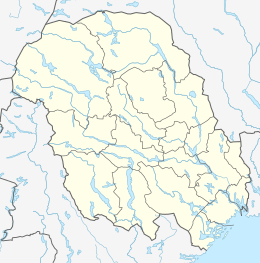Rjukan
| Rjukan | |
|---|---|
| City | |
|
Panorama of Rjukan city, 2015 | |
 Rjukan Location in Telemark | |
| Coordinates: 59°52′44″N 08°35′38″E / 59.87889°N 8.59389°ECoordinates: 59°52′44″N 08°35′38″E / 59.87889°N 8.59389°E | |
| Country | Norway |
| Region | Austlandet |
| County | Telemark |
| District | Aust-Telemark |
| Population (2007) | |
| • Total | 3,386 |

Rjukan (Norwegian: [ˈrjʉːkɑn]) is a town and the administrative centre of Tinn municipality in Telemark, Norway. It is situated in Vestfjorddalen, between Møsvatn and Lake Tinn, and got its name after Rjukan Falls ('the smoking waterfall') west of the town. The Tinn municipality council granted township status for Rjukan in 1996. The town has 3,386 inhabitants (Jan. 2007).
History
Rjukan was formerly a significant industrial centre in Telemark, and the town was established between 1905 and 1916, when Norsk Hydro started saltpetre (fertilizer) production there. Rjukan was chosen because Rjukan Falls, a 104-metre waterfall, provided easy means of generating large quantities of electricity. The man with the idea to use the Rjukan falls was Sam Eyde, the founder of Hydro. It is estimated that he, together with A/S Rjukanfoss (later Norsk Hydro), used about two times the national budget of Norway to build Rjukan and that there were approximately 12,000 workers (Rallare) from Sweden, Denmark, and Finland, as well as Norway building the factories and the town.
In 1934 Norsk Hydro built what was at the time the world's largest power plant at Vemork in Rjukan, and with it a hydrogen plant. A by-product of hydrogen production via water electrolysis was heavy water. It was the later Nobel prize winner Odd Hassel who told Norsk Hydro that they were in fact producing heavy water. The Norsk Hydro was run by the Germans during World War II, and later sabotaged multiple times by the Norwegian resistance movement and the allied forces.
Today, the power plant at Vemork has been made into the Norwegian Industrial Workers Museum where the history of Rjukan and a history of Industrial labour is displayed, in addition to history of the war and the sabotage connected to it.
After 1960, most of the saltpetre production in Rjukan was transferred to Norsk Hydro factories at Herøya in Porsgrunn. Some industry is still present in Rjukan, among them Scan Alloys.
Rjukan has a long history of tourism. Tourists have come to the narrow valley for over a century. Rjukan Falls is a famous landmark in Norway, and has been portrayed by several famous artists. The area has good terrain for skiing, and the town is a good starting point for hiking on the Hardangervidda plateau. In the 1860s, Krokan by the Rjukan waterfall was Norwegian Mountain Touring Association's (DNT) first hut. After the waterfall was harnessed for hydro power production the hut was sold. Today it is re-opened, situated by the main road from Rjukan (Tinn) to Vinje. In later years Rjukan has become famous for its ice climbing possibilities. The season is long, from November to April and the waterfalls are many and varied.
Between September and March, Rjukan lies in the shadow of the mountains and does not get sunlight. In 2013, at a cost of 5 million Norwegian kroner, large mirrors were placed on the mountainside to reflect the sun to illuminate the town square.[1][2]
See also
- Norwegian heavy water sabotage during World War II
- Norsk Hydro Rjukan
References
- ↑ Stefan Nordberg. "Inklämda byn som får solljuset från speglar" Ny Teknik, 22 October 2013. Accessed: 22 October 2013.
- ↑ Harriet Alexander. "Norwegian town places mirrors on hillsides to shine light into valley" The Daily Telegraph, 23 October 2013. Accessed: 24 October 2013.
External links
| Wikimedia Commons has media related to Rjukan. |
| Wikivoyage has a travel guide for Rjukan. |
|
|
- Rjukan lag of Norwegian search and rescue dogs
- Ice climbing in Rjukan
- Postcard from Tinn
- Postmarks/cancels from Tinn
- Climbing, mountain bike and skiing in Rjukan